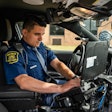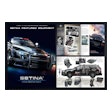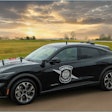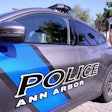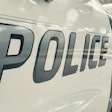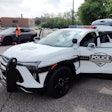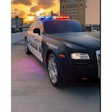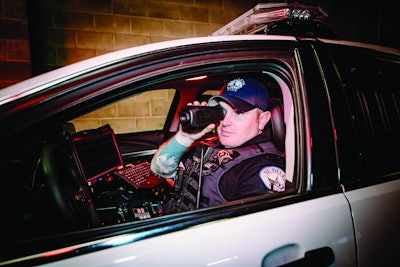 Thermal systems such as this FLIR Systems Scion PTM cannot "see" through glass. So users must roll down the window or use an externally mounted system.Photo: FLIR Systems
Thermal systems such as this FLIR Systems Scion PTM cannot "see" through glass. So users must roll down the window or use an externally mounted system.Photo: FLIR Systems
The first practical night vision systems were mounted on World War II tanks. With good reason; they were not exactly man-portable. Today, however, when we think of night vision systems, we generally don't think about vehicles.
Night vision systems in law enforcement are most common today on the helmets of tactical operators working to achieve an objective with stealth and surprise. They're also often seen in the hands of officers surveilling a location or a person or searching for someone lost in the woods. What is less known is that law enforcement vehicle operators, including helicopter pilots, often use night vision to enhance their capabilities.
Aviation NVG
There are two types of night vision commonly used in law enforcement aviation operations: light intensification and thermal systems. Light intensification systems are the tubed goggles that take small amounts of ambient light such as that from the stars and moon and amplify it to the point where you can see in the dark. Thermal systems use sensors to convert the temperature differential between objects and living things and their surroundings into visible images.
Guy Blocker, field applications and law enforcement business development manager for FLIR Systems (www.flir.com), has long used and instructed others on how to use both types of night vision for both ground and air operations. He says flying a helicopter with night vision goggles (NVG) gives the pilot a better idea of what hazards including power lines and hillsides await in the dark.
Blocker, who piloted helicopters for the Army in some of the earliest NVG aviation programs, says the best night vision systems for pilots are dual tube goggles. "You need both eyes in the system so you are not getting mixed signals," he explains.
There are many benefits of a dual tube system for pilots, according to Blocker. These include depth perception and distance estimation. "When you have one eye in and one eye out, you are constantly second guessing yourself and that's not the time to be doing that."
In addition to safety, another reason that more and more law enforcement pilots are flying at night with NVG is stealth. Image intensification lets them fly in the dark, and it lets them use infrared spotlights not readily visible to the naked eye to light up targets on the ground. Blocker says that unless the suspect knows what to look for, he'll hear the helicopter but not see it.
Aviation Thermal
Police aviation teams consist of a pilot and an observer working together. One of the jobs of the observer is to track the suspect on the ground using forward looking infrared (FLIR). One of the manufacturers of these systems is Blocker's employer, FLIR Systems.
The FLIR camera is usually mounted on a gimbal on the bottom of the helicopter, and the user inside the helicopter can maneuver the system to pinpoint the suspect on the ground. Blocker says the FLIR cameras on law enforcement helicopters have cooled systems and larger lenses that give them much greater capabilities than the smaller systems used on the ground. "You can pick out targets at a mile or two miles while orbiting at 2,000 feet," he explains.
On the Ground
Blocker says that in the same fashion that NVG are used to pilot helicopters at night they can also be used to drive ground vehicles. "You can turn off the lights and drive down the road as if your vehicle was illuminated by headlights," he says. Typical law enforcement applications for driving with NVG include SWAT operations that require stealth and game wardens searching for poachers. In addition to driving with NVG, officers often use night vision tools for surveillance from vehicles.
Although it cannot be used to operate the vehicle in the dark, thermal imaging is commonly used in vehicles during a wide variety of public safety operations, including search and rescue and evidence search (residual heat from a person's hand can be seen on the discarded object).
 Noptic thermal imaging system atop patrol vehicle spotlight. Noptic uses the pan and tilt capabilities of the spotlight system to give officers the ability to view a specific target. The system comes with a spotlight head.Photo: MSM Public Safety
Noptic thermal imaging system atop patrol vehicle spotlight. Noptic uses the pan and tilt capabilities of the spotlight system to give officers the ability to view a specific target. The system comes with a spotlight head.Photo: MSM Public Safety
Mike Martin, president of MSM Public Safety, says thermal imaging can also be an excellent officer safety tool. MSM Public Safety (info@nopticthermalcamera.com) is the largest U.S. distributor of the Noptic thermal surveillance system.
The Noptic system mounts onto a patrol vehicle spotlight and can alert officers to potential threats hidden in the night. Martin says the system ships with a spotlight head so that it can easily be installed on a vehicle spotlight platform for full pan and tilt operation. It also comes with a USB cable and software so that the patrol vehicle's computer can be used for viewing the images it captures.
Noptic can be used while the vehicle is stationary or while traveling at slow enough speed so the officer can glance at the computer screen. "That way you can sweep an area looking for a suspect," Martin says.
Optimal range for Noptic is 500 yards. But Martin says he has picked up faint signatures at half a mile. "If you can see it during the day, you can see it at night with Noptic," he says.
Because it is a thermal imager, Noptic can see threats or suspects hiding in greenery such as shrubs or even woods. "The tactical advantage of Noptic is it gives law enforcement professionals the ability to see heat signatures in the dark. You may not know if it's a threat, but you know someone is out there," he says.
Martin adds: "Noptic is such a powerful officer safety tool that many of my clients tell me they don't want to work in a patrol car that doesn't have one."











